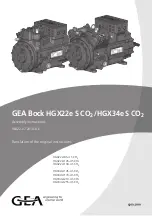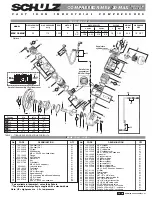
11
WARNING: Overheating
This compressor is equipped with “auto shut off”.
However, failure to allow adequate cooling ventilation or
a restriction in the intake airflow may cause the
machine to overheat.
WARNING: Inflatables/Low PSI tire
Never use compressor to inflate small low-pressure
objects, i.e., balloons/inflatables, small or low volume
PSI tires. It is easy to over-pressurize them, causing
them to rupture. Identify the inflation capacity of an
object prior to filling it with air. Use a gauge to check the
pressure regularly when inflating anything.
Proper Air Hose and Tool Use
Pressure Control Related Devices
Never remove, adjust, bypass, change, modify or make
substitutions for safety/relief valves, pressure switches
or other pressure control related devices. Pressurizing
beyond the limits of the compressor could result in an
explosion.
WARNING: Overpressurization hazard
NEVER over-pressurize the receiver tank or air tools
beyond nameplate capacity. Exceeding the pressure
rating could cause them to explode or fly apart.
Compressor - Tool Requirements
Compressor and attachments must be sized properly
for pressure and air volume.
Consider the maximum pressure requirements and
air volume requirements of each. (The volume rating
of your compressor is listed in the “
Specifications
”
section.)
CAUTION: Tool overpressure hazard
Do not operate this unit with any tool rated less than the
maximum operating pressure of the unit (135 PSI)
unless a properly sized regulator limiting pressure is
used before the tool.
Attaching/Disconnecting Air Hose and Tools
CAUTION: High pressure stream hazard
High-pressure air stream can pierce skin and underlying
tissues, leading to serious injury and possible
amputation. Such an injection injury can result in blood
poisoning and/or severe tissue damage. High-pressure
air stream can also cause flying debris and possible
surface damage.
CAUTION: Air tools hazard
Do not attach air tools to open end of the hose until
start-up is completed and the unit checks out OK.
Quick Connect Procedure:
Keep finger off tool or activation switch until ready
to use.
Pull quick connect collar back (Figure 14a).
Push hose or attachment firmly against stop.
Let go of collar (Figure 14a).
Pull and rotate slightly (hose or attachment) to
assure a tight connection.
WARNING: Projectile hazard
Air tool or attachment can become a projectile and
cause serious personal injury or damage if not securely
attached to the air hose.
Figure 14a
Figure 14b Figure 14c
Using Compressor for Spraying
Flammable Materials
Always follow precautions on container labels or “SDS”
before spraying flammable materials, such as paint.
Moisture in Compressed Air
Moisture in supply air when compressed will form into
droplets as it leaves air compressor pump and enters
receiver tank. When humidity is high or when a
compressor is in continuous use for an extended period
of time, a significant amount of moisture will collect in
the tank. Part of the moisture will be discharged in the
outlet air.
When using a paint spray or sandblast gun, this water
will be carried from the tank through the hose, and out of
the gun as droplets mixed with the spray material. If this
is not acceptable for your application, an external air
dryer must be added to the system.
Collar
Coupler
Quick Disconnect
Socket
Correct
Insertion
Not Fully
Inserted
Collar Seated
Collar NOT Seated
Tool




































